Automated test is a form of testing to record the manual testing steps and then re-runs the recorded steps without performing the entire test manually again. The other type is to write scripts using programming language to automate the service level testing. Automating user interface (UI) testing was the biggest challenge but nowadays a few tools provide the flexibility to record user actions and create a script out of it. It is made simpler in Microsoft Visual Studio 2012. These tests are also called coded UI tests. The existing manual tests, test cases, and the action recordings of the user interface tests are re-used for generating the automated tests and the code files in the managed code (C# or VB.NET).
The UI controls can be added to the coded UI test and then the properties and values of controls can be verified using the Coded UI Test Builder feature. To conduct the same test multiple times but with different sets of data, the coded UI test can be made as a data-driven test by adding a data source to the test. The test would then be called for each row of data in the data source.
The coded UI test can be run directly from Visual Studio or Microsoft Test Manager and can be linked to the requirements to determine the number of automated tests for each requirement and also to gather the Test Results for the requirement.
Action recording is a very useful feature for recording user actions and then creating test scripts out of it. The test scripts can be customized or used as is to play back the test instead of repeating the same test manually. Recording of actions is done using the Test Runner. The details of creating and recording the user actions are covered as part of Chapter 2, Test Plan, Test Suite, and Manual Testing which talks about Test Plans and manual testing. This section explains the details of creating a coded UI test from an existing action recording. The following image shows the successful completion of action recording for the manual test.
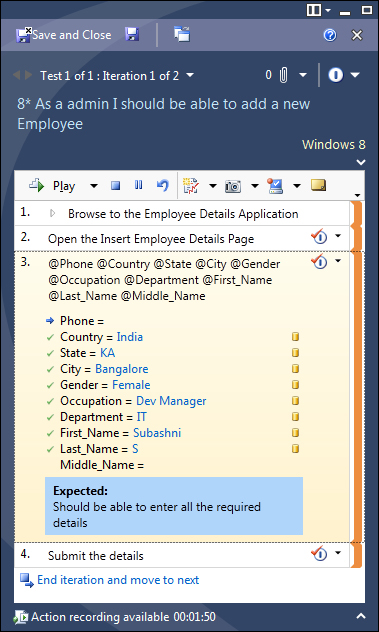
Follow these steps to create the coded UI test:
- In Visual Studio, select the Test Project from the solution explorer, if the Test Project already exists in the solution and then add a new test to the project using the context menu.
Otherwise select Project from the main menu and then select Add Coded UI Test from the list of options available.
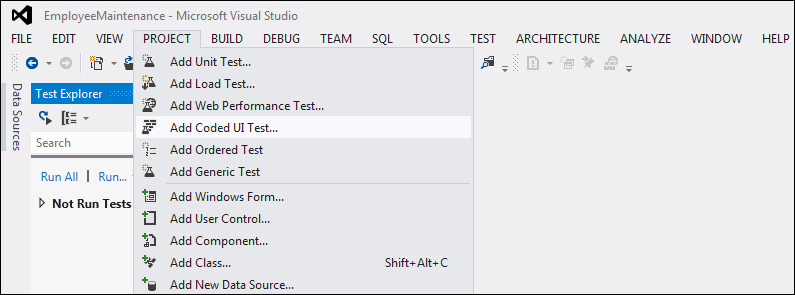
- The selected Coded UI Test option will add the code file to the Test Project. The code file will contain only the class with the
CodedUITestattribute, a test method namedCodedUITestMethod1with the attributeTestMethodand a test context. All these methods are empty as the code for the test is not yet generated. - After selecting the coded UI test menu, there are two options available for creating the test. One is to Record actions, edit UI map or add assertions, which is like starting everything from the beginning. The second option is to Use an existing action recording for the manual test.
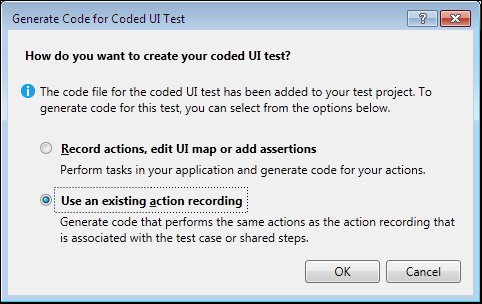
Choose the second option to use the existing action recording which was recorded as part of manual testing in Chapter 2, Test Plan, Test Suite, and Manual Testing. After choosing the Use an existing action recording, select the work item using the Work Items Picker screen which is displayed. Use the filter options to filter the manual test case for which the action recording is available.
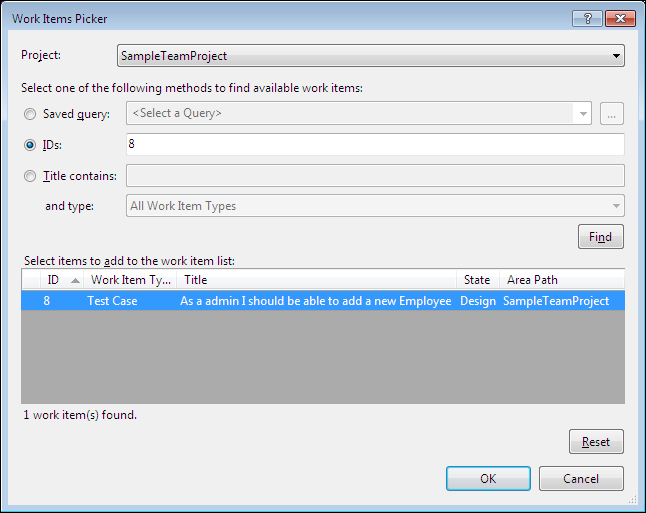
- Select the test case from this window will generate the code based on the action recording.
Additional files such as UIMap.uitest, UIMap.cs, and UIMap.Designer.cs are created at the time of code generation. The main method CodedUITestMethod1() in the CodedUITest1.cs file contains calls for the methods created for each action while recording the user actions. The corresponding method definition is created in the UIMap.Designer.cs file by the Coded UI Test Builder itself. The code below contains the action methods generated under CodedUITestMethod1():
This is the sample code for the action method in the class.
[DataSource("Microsoft.VisualStudio.TestTools.DataSource.TestCase"
, http://my-machine1:8080/tfs/defaultcollection;SampleTeamProject
, "8", DataAccessMethod.Sequential), TestMethod]
public void CodedUITestMethod1()
{
// To generate code for this test, select
"Generate Code for Coded UI Test" from the shortcut menu
and select one of the menu items.
// For more information on generated code,
see http://go.microsoft.com/fwlink/?LinkId=179463
this.UIMap.BrowsetotheEmployeeDetailsApplication();
this.UIMap.OpentheInsertEmployeeDetailsPage();
this.UIMap.PhoneCountryStateCityGenderOccupationDepartment
First_NameLast_NameMiddle_NameParams.UICountryEditText =
TestContext.DataRow["Country"].ToString();
this.UIMap.PhoneCountryStateCityGenderOccupationDepartment
First_NameLast_NameMiddle_NameParams.UIStateEditText =
TestContext.DataRow["State"].ToString();
this.UIMap.PhoneCountryStateCityGenderOccupationDepartment
First_NameLast_NameMiddle_NameParams.UICityEditText =
TestContext.DataRow["City"].ToString();
this.UIMap.PhoneCountryStateCityGenderOccupationDepartment
First_NameLast_NameMiddle_NameParams.UIGenderEditText =
TestContext.DataRow["Gender"].ToString();
this.UIMap.PhoneCountryStateCityGenderOccupationDepartment
First_NameLast_NameMiddle_NameParams.UIOccupationEditText =
TestContext.DataRow["Occupation"].ToString();
this.UIMap.PhoneCountryStateCityGenderOccupationDepartment
First_NameLast_NameMiddle_NameParams.UIDepartmentEditText =
TestContext.DataRow["Department"].ToString();
this.UIMap.PhoneCountryStateCityGenderOccupationDepartment
First_NameLast_NameMiddle_NameParams.UIFirst_NameEditText =
TestContext.DataRow["First_Name"].ToString();
this.UIMap.PhoneCountryStateCityGenderOccupationDepartment
First_NameLast_NameMiddle_NameParams.UILast_NameEditText =
TestContext.DataRow["Last_Name"].ToString();
this.UIMap.PhoneCountryStateCityGenderOccupationDepartment
First_NameLast_NameMiddle_Name();
this.UIMap.Submitthedetails();
}The coded UI test code generation creates several files and adds them to the Test Project. We will now see the details of each file that gets generated.
While creating the coded UI test, the Test Builder generates multiple files to map the user interface, test methods, parameters, and assertions for all tests.
The name of this file is generated based on the name of the test that is created. This file can be modified any time. This file contains one public class with the name CodedUITest1, with the CodedUITest attribute added to the class so that this class can be recognized as a test class. The name CodedUITest1 is the default name chosen by the system. If this file already exists, the system increments the number associated with the name and then creates the file with the new name.
The class also contains two default properties, TestContext and UIMap.
The following screenshot shows the default properties:
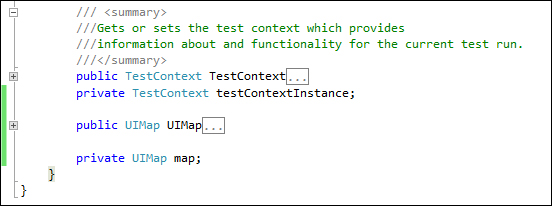
There are two additional methods which are commented out by default. A region titled Additional test attributes contains these two optional methods, as shown in the following screenshot:
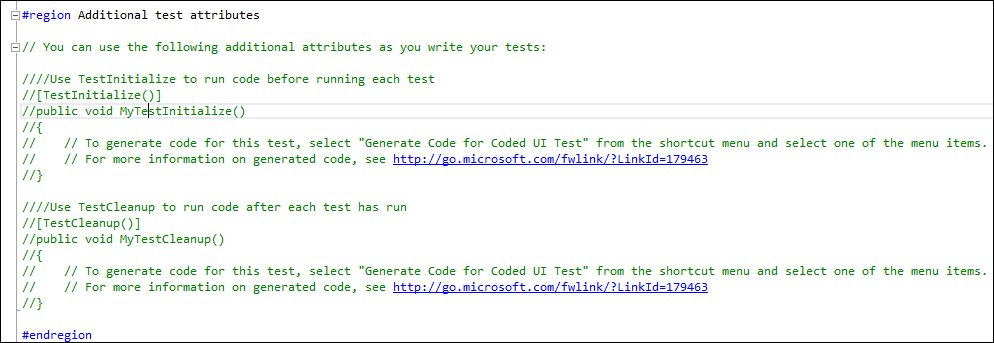
The MyTestInitialize() method is called once before any other test methods during the Test Run. This is useful for initializing the tests and is identified as the initializer using the attribute TestInitialize. Similarly the method MyTestCleanup() method is called once after all the tests have been called, and this method is identified using the attribute TestCleanup().
The Coded UI Test Builder automatically creates the code in this file when a test is created. The file gets updated whenever the test is modified. This file contains a UIMap class which has the attribute GeneratedCode. All classes in this file are auto generated codes and every class has the attribute GeneratedCode associated with it. The UIMap class contains the definition of all the methods that were identified during recording. Following are some of the methods captured during recording:
public void BrowsetotheEmployeeDetailsApplication() public void OpentheInsertEmployeeDetailsPage() public void Submitthedetails()
The definition of each method follows a defined structure. The structure contains a summary of the method, a region at the top defining the variables, and then the definitions of the method calls and properties. The following code shows the definition for one of the method calls:
/// <summary>
/// BrowsetotheEmployeeDetailsApplication – Shared Steps 14 –
Use 'BrowsetotheEmployeeDetailsApplicationParams' to pass
parameters into this method.
/// </summary>
public void BrowsetotheEmployeeDetailsApplication()
{
#region Variable Declarations
HtmlHyperlink uIEmployeeHyperlink =
this.UIBlankPageWindowsInteWindow.
UIEmployeeMaintenanceDocument.UIEmployeeHyperlink;
#endregion
// Go to web page 'http://localhost:3062/' using new browser
instance
this.UIBlankPageWindowsInteWindow.LaunchUrl(new System.Uri
(this. BrowsetotheEmployeeDetailsApplicationParams.
UIBlankPageWindowsInteWindowUrl));
// Click 'Employee' link
Mouse.Click(uIEmployeeHyperlink, new Point(17, 9));
}This file contains the partial UIMap class but does not contain any properties or methods initially. However, custom code can be included in the UIMap class to customize the existing functionality or add new functionality.
This is an XML file which represents the structure of the coded UI test recording. These include the actions, properties, and methods of the classes. The UIMap.Designer.cs file contains definitions of all the methods that are generated by the coded UI Builder. As the UIMap test files are generated by the Test Builder, it is not advisable to edit the files directly, but rather to use the UIMap editor to work with the methods. Every time there is a change to the recording or to the controls in the recording the file is regenerated and overwrites the custom code, which is the reason why we do not modify the generated code. The following screenshot shows the editor with the list of recorded actions and the corresponding UI controls. The Click 'Employee' link is the action which corresponds to the UIEmployeeHyperLink.
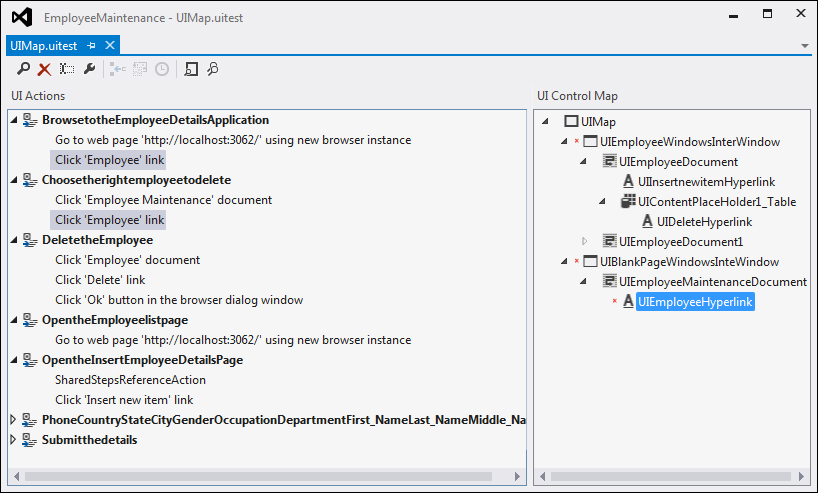
The editor contains options to delete a method, rename the method, set properties, split into a new method, move code to the UIMap.cs file, insert delays, and locate controls. The following screenshot shows the properties window for one of the user actions - in this case, to go to the web page:
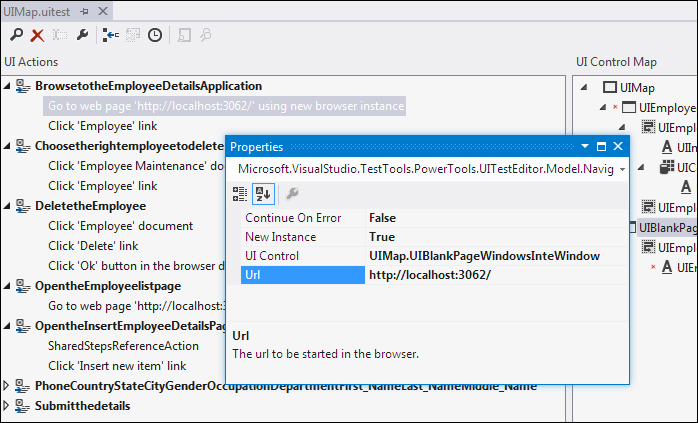
The other main functionality in the editor is to move the code to the UIMap.cs file. Initially the UIMap.cs file would be an empty class without any implementation. If there is any customization required, it is not advisable to directly edit in the designer.cs file, but the method can be moved to the UIMap.cs file and then the customization can be done. Choosing the Move code to UIMap.cs option provides a warning saying the method will be removed from the UIMap.uitest file and moved to UIMap.cs and you will not be able to edit the method using coded UI test.
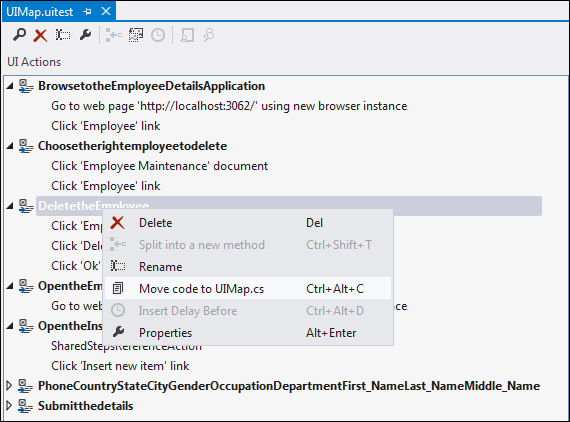
Choosing the Move code to UIMap.cs option provides a warning saying the method will be removed from UIMap.uitest and moved to the UIMap.cs file and you will not be able to edit the method using coded UI test, as shown in the following screenshot:
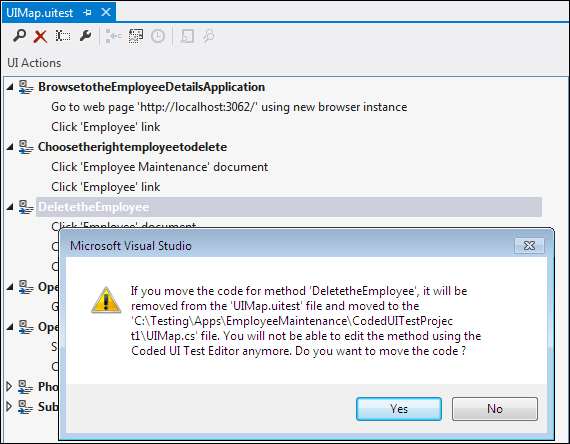
Once you confirm the code move, the method is removed from UIMap.uitest and copied to UIMap.cs and is ready for customization.
The coded UI test that was created previously is for a given set of data captured during test recording. Later on, the test may be required not only for one set of data but for different sets of data and for multiple times. To achieve this, we parameterize each field to get data from a data source during testing. Each row of data in the data source is an iteration of coded UI test. When generating methods or assertions for the coded UI test, all constants in the recorded methods are parameterized into parameter classes. In the previous code example, there is a BrowsetotheEmployeeDetailsApplication method as shown in the following code:
/// <summary>
/// BrowsetotheEmployeeDetailsApplication – Shared Steps 14 –
Use 'BrowsetotheEmployeeDetailsApplicationParams' to pass
parameters into this method.
/// </summary>
public void BrowsetotheEmployeeDetailsApplication()
{
#region Variable Declarations
HtmlHyperlink uIEmployeeHyperlink =
this.UIBlankPageWindowsInteWindow.
UIEmployeeMaintenanceDocument.UIEmployeeHyperlink;
#endregion
// Go to web page 'http://localhost:3062/' using new
browser instance
this.UIBlankPageWindowsInteWindow.LaunchUrl(new System.Uri
(this. BrowsetotheEmployeeDetailsApplicationParams.
UIBlankPageWindowsInteWindowUrl));
// Click 'Employee' link
Mouse.Click(uIEmployeeHyperlink, new Point(17, 9));
}For the above method the Coded UI Test Builder creates the class as shown in the following code and adds fields to the class for every constant value used while recording.
public HtmlHyperlink UIEmployeeHyperlink
{
get
{
if ((this.mUIEmployeeHyperlink == null))
{
this.mUIEmployeeHyperlink = new HtmlHyperlink(this);
#region Search Criteria
this.mUIEmployeeHyperlink.SearchProperties
[HtmlHyperlink.PropertyNames.Id] =
"ContentPlaceHolder1_Menu1_HyperLink1_2";
this.mUIEmployeeHyperlink.SearchProperties
[HtmlHyperlink.PropertyNames.Name] = null;
this.mUIEmployeeHyperlink.SearchProperties
[HtmlHyperlink.PropertyNames.Target] = null;
this.mUIEmployeeHyperlink.SearchProperties
[HtmlHyperlink.PropertyNames.InnerText] = "Employee";
this.mUIEmployeeHyperlink.FilterProperties
[HtmlHyperlink.PropertyNames.AbsolutePath] =
"/Employee/List.aspx";
this.mUIEmployeeHyperlink.FilterProperties
[HtmlHyperlink.PropertyNames.Title] = null;
this.mUIEmployeeHyperlink.FilterProperties
[HtmlHyperlink.PropertyNames.Href] =
"http://localhost:3062/Employee/List.aspx";
this.mUIEmployeeHyperlink.FilterProperties
[HtmlHyperlink.PropertyNames.Class] = null;
this.mUIEmployeeHyperlink.FilterProperties
[HtmlHyperlink.PropertyNames.ControlDefinition] =
"id=ContentPlaceHolder1_Menu1_HyperLink1_";
this.mUIEmployeeHyperlink.FilterProperties
[HtmlHyperlink.PropertyNames.TagInstance] = "5";
this.mUIEmployeeHyperlink.WindowTitles.Add
("Employee Maintenance");
#endregion
}
return this.mUIEmployeeHyperlink;
}
}
#endregion
#region Fields
private HtmlHyperlink mUIEmployeeHyperlink;
#endregion
}Now the required test and test files are created. Let us create a data source in the form of a .csv file and use it for the coded UI test. The sample data in the .csv file is shown in the following screenshot:

Select the test method from the class file and insert the data source attribute directly in the code in the line immediately above the method. The earlier Version of Visual Studio has the data source wizard to associate the data source to the test method. But VS 2012 does not have the wizard. Just add the data source attribute and start using the data columns and rows as follows:
[DataSource("Microsoft.VisualStudio.TestTools.DataSource.CSV", "|DataDirectory|\data.csv", "data#csv", DataAccessMethod.Sequential), DeploymentItem("data.csv"), TestMethod]Save the changes to the CodedUITest1.cs file. Now right-click the coded UI test in the code editor and choose Run Unit Test. After the test is run, the overall Test Result for all iterations is displayed in the Test Results window.
If the CodedUITest1 test is run now, the test would run for each row in the data source. As there are three rows in the data source the test would run three times. Even if one of these tests fails, the entire Test Result would fail.
What is shown in the preceding screenshot is only the CSV data source but there are multiple other data sources, such as XML file, Microsoft Excel, test cases in Team Foundation Server, and SQL Express.
Sometimes some kind of validation is required for UI controls. For example, some of the controls in the UI should not be null. Use the Coded UI Test Builder to generate code for the validation method that uses an assertion for a UI Control. Add the UI control to the existing UI map file and generate the code to the existing coded UI test file.
Open the Test Project and the coded UI test file, which is named CodedUITest1.cs. In the code file place the cursor on CodedUITestMethod1(), right-click and select the option Generate code for Coded UI Test and then choose Use Coded UI Test Builder.

The Coded UI Test Builder opens with menu options for adding controls and validations. Open the application and then open the UI page for which we need to add the validation logic. Keeping the UI open, simply drag-and-drop the crosshair from the Test Builder to the control on the UI. The other option is to select the control then keep the mouse pointer on the UI Control while pressing the Windows logo key + I to select the control at the mouse pointer.
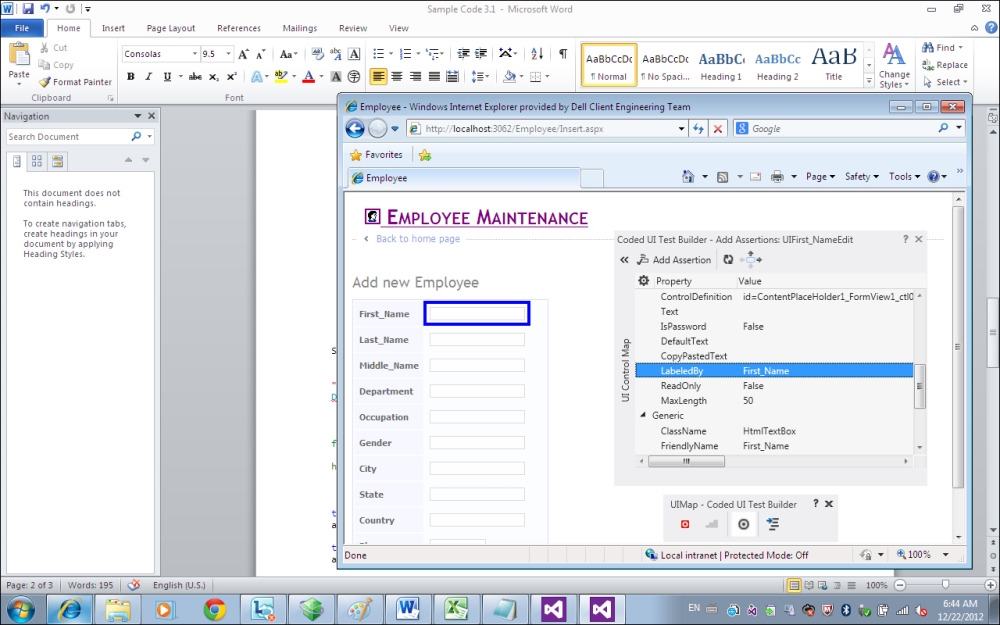
After selecting a control, the Add Assertions screen opens for the selected control. The window displays all the properties of the selected control. Select the property of the control to be validated and then click on the Add Assertion option. The following image shows the window to select the assertion type, add the Comparison Value for the validation, and to provide the Message on Assertion Failure.
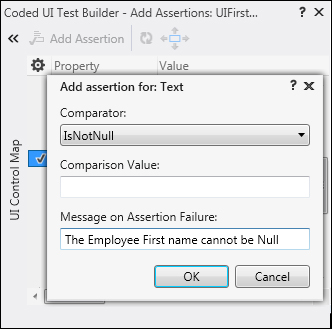
Just for testing purposes, let's add an IsNotNull assertion type for the first name UI control for the Text property of the control. Click on Ok to add the assertion to the test. Keep adding assertions for all validations required for the controls. Once all required assertions are added, click on the Generate code option in the Test Builder and provide name for the assert methods that were added. This option automatically creates the code for assertions and adds the method definition and method calls to the corresponding files.
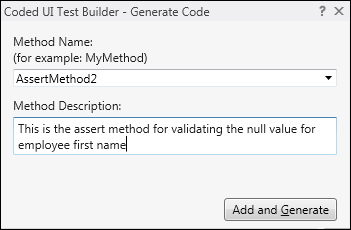
All assertion method definitions are added to the UIMap.Designer.cs file and the method is called from the main method CodedUITestMethod1() in the CodedUITest1.cs file. The following code shows the code for the assertion generated in the designer file:
/// <summary>
// This is the assert method for validating the null value
for employee first name
/// </summary>
public void AssertMethod2()
{
#region Variable Declarations
HtmlEdit uIFirst_NameEdit =
this.UIEmployeeWindowsInterWindow.UIEmployeeDocument1.
UIFirst_NameEdit;
#endregion
// Verify that the 'Text' property of 'First_Name'
text box is not equal to 'null'
Assert.IsNotNull(uIFirst_NameEdit.Text,
"The Employee First Name cannot be Null");
}Now to test the assertion functionality, open the data source CSV file and empty the values for the first name of all the employees in the file. Navigate to CodedUITest1 from the Test Explorer window and run the test. As there are three rows in the data source, there will be three iterations of the test run, and all three will fail because the first name is null in all rows. The test is checking for a not null value in the first name field. So the entire test would fail because of the tests failure.
Now the required coded UI testing is successful. One difficulty in this type of code generation is the code maintenance. As we know that all the assertion codes and the validation methods are added to the UIMap class, there is chance of this class file growing to a larger size, if we keep on adding the controls and methods. To avoid this situation, multiple UIMap files can be generated.
The application can be grouped into modules or logical subsets, and each UIMap file mapped to one particular logical subset of the application. This logical grouping also helps the tester to work on an individual module without affecting other areas of the application. To create the logical grouping, first create a folder under Test Project. Then select the folder and create a new item of type Coded UI Test Map from the available templates as follows:
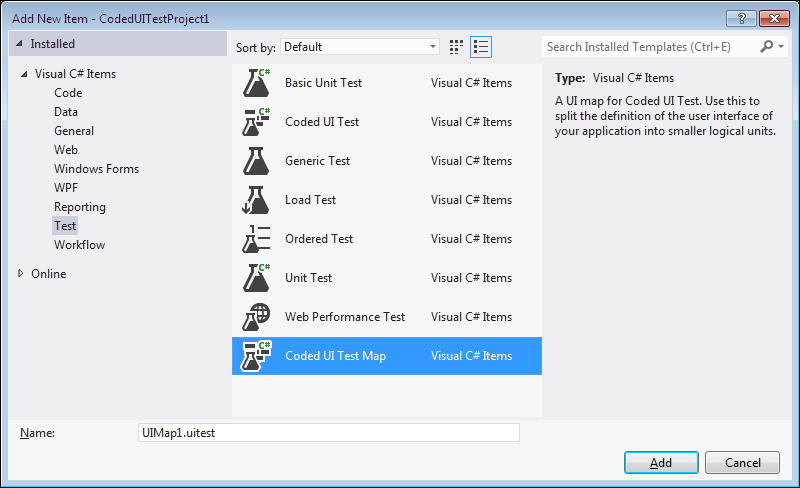
Click on Add after providing a name for the new Map file. The Coded UI Test Builder window will now appear after minimizing the Visual Studio window. Using the Test Builder, keep recording the actions and creating the validations for the UI controls. Make sure of adding controls and validation specific to the module for which the map file is created. Generate the code using the option in the Test Builder after completing the recording. You can see the new .uitest file and designer.cs files added to the test under the new folder. The following image shows the new UIMap files created under the new folder:
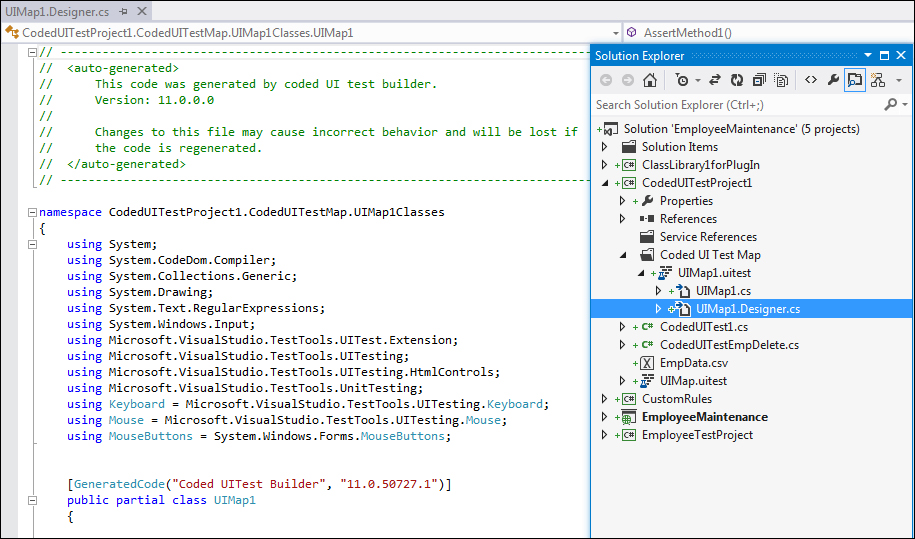
For any mapping that we create there are certain best practices to follow for easy maintenance and successful Test Results, such as:
- Do not modify the
UIMap.Designer.csfile as it is meant only for the Test Builder to modify. - Always use Coded UI Test Builder to create all assertions and limit the recording to few user actions.
- Use meaningful names for the
UIMapfiles and the assertion methods to easily identify and maintain the code and tests. - Always re-record the user actions after any changes to the user interface.
